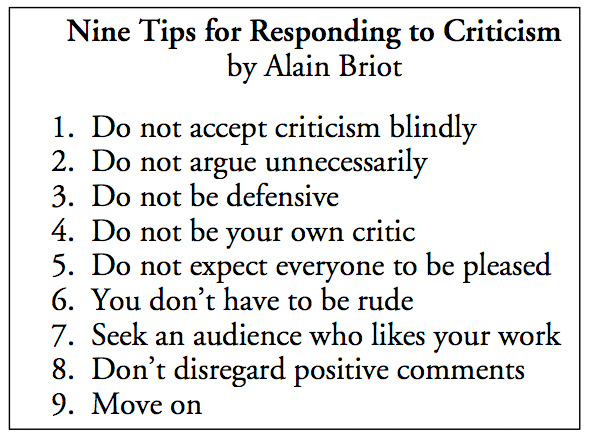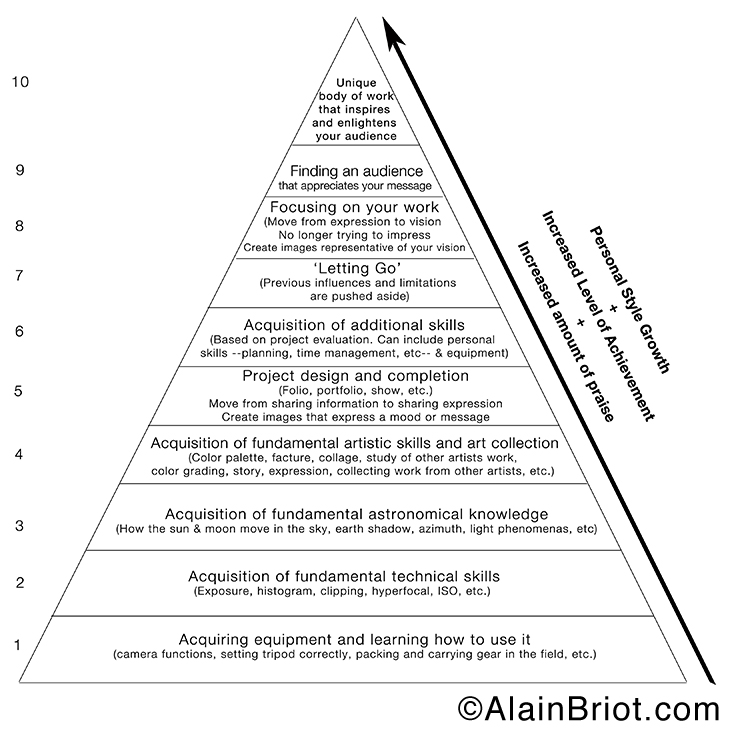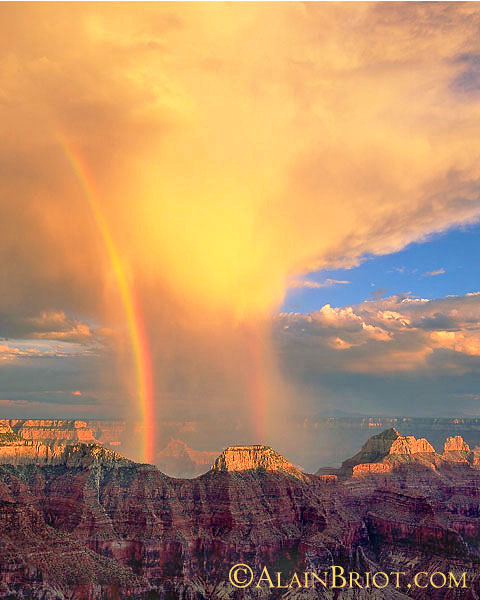

by
Alain Briot
He who stands aloof runs the risk of believing himself better than others
and misusing his critique of society as an ideology for his private interest.
Theodor Adorno
1 – Introduction
Finding and expressing our vision involves having our work critiqued in order to know where we are at and how others respond to our images.
For me critiquing photographs is synonymous with reviewing a selection of prints. Of course, the subject can be extended to critiquing any photographs, including those seen in an exhibition or a publication for example. However, for the purpose of this essay I am purposefully limiting the scope of my remarks to what is commonly referred to as ‘a print review.’
A print review, or print critique, can take place in a variety of contexts including a photography workshop, a photo club meeting, an informal gathering of photographers or other.
A print critique is an important event in the life of a photographer. The purpose of this essay is to offer guidance to make this event constructive rather than destructive.
2 – Critiquing is not criticizing
Personally, I see a difference between critiquing and criticizing a photograph, or any work of art for that matter. For me critiquing means looking at the work for the purpose of finding out the strong and weak points of the work. On the other hand criticizing means taking a critical look at the work for the purpose of expressing a personal opinion. While there is a gray area between the two, I view the former as constructive and the later as destructive.
3 – Address the different aspects of photography
A good critique is one that addresses all the issues involved in creating world class fine art photographs. These include the technical aspects, artistic aspects, image processing, printing, composition, field work, etc. Most importantly, a good review covers both hard skills and soft skills.
4 – Critique technical and artistic aspects separately
Technical aspects include focus, sharpness, exposure, processing, optimizing, cropping, collaging, HDR, printing and other technical aspects.
Artistic aspects includes composition, light quality, color palette, facture, presence or absence of a recognizable personal style across a collection of images, creativity, motivation and other artistic aspects.
5 – Arrange critique by subject matter
You cannot critique different types of photography in the same manner. While good photographs share common characteristics, each genre has specific characteristics. For that reason it is important that the reviewer has expertise in the type of photography being reviewed. For example it is best to have a portrait photographer review portraits, a landscape photographer review landscapes and so on. This is because you cannot review portraits, landscapes and other genres the same way.
6 – Good lighting is essential
The physical conditions of the review are just as important as the qualifications and the approach used by the reviewer. Among those one of the most important is lighting. Having good lighting, consistent from review to review, is essential. Photographs depend on lighting to be seen properly. Overly dark or bright lighting conditions will affect the print viewing experience negatively, leading to commentaries about the print being too bright or too dark. Similarly, lighting should be calibrated for daylight if the review is done indoors. If the review is done outdoors, midday light in a shaded area is best.
7 – Print versus screen
I prefer to review prints because this is what I exhibit and sell. However, I am not opposed to reviewing images on screen as long as the viewing device is calibrated. However, when doing a screen review I do mention that I cannot vouch on the print quality because there is nothing automatic in going from a screen image to a printed image. How the image prints out is fully dependent on the photographer’s printing skills.
8 – Be factual, not opinionated
The reviewer’s behavior is just as important as the reviewers’ knowledge. As the old adage says, no one cares about how much you know until they know how much you care.
Make your critique factual, not opinionated. An example of a fact-based critique is: ‘this print is blurry because the camera was used handheld and the shutter speed was too slow.’ Sharpness is a verifiable fact and if the photographer wanted to create a sharp image there is something wrong with the resulting photograph.
An example of an opinion-based critique is: ‘I don’t like blue so I suggest you change the color of the image to a warm tone.’ Color choice is matter of personal taste and if the photographer chose that color intentionally there is nothing wrong with this decision.

Grand Canyon Sunrise
9 – Keep your opinions about art to yourself
You don’t have to like a specific photograph in order to make meaningful comments about it. You may not want to hang this photograph in your living room, however that doesn’t mean it is devoid of qualities. Point to what works and what does not work in the photograph in regards to artistic and technical aspects and keep your personal taste in art private.
10 – Adjust your critique to the skill and achievement level of the photographer
There is no point critiquing the work for having a lack of vision if the photographer does not know how to set his tripod correctly! For this to work you have to set a hierarchy of importance. This is the purpose of the skills evaluation pyramid (below).
You can’t evaluate and critique the work of a beginner the same way that you evaluate and critique the work of a photographer with 40 years of experience. Doing so is not only unfair, it is simply absurd.
Therefore you have to adjust your evaluation according to the skill, knowledge and experience level of each student. While the ultimate goal remains learning how to create world class images, the goal of a print review is to assess where the student is at and point to specific things this student can do in order to reach the next step.
11 – Explain what you find to be the number one problem
Do so in a clear and concise manner. It is not possible to fix everything at once. A photo may have several problems, but usually one stands out as the most important. That’s the one that needs to be addressed first. For example, if a photo is not very sharp and taken in poor light (at noon for example), the thing that needs fixing first is learning to take photos in good light. Who cares if the photo is not sharp if it is not interesting. Light quality is much more important than sharpness. Nobody cares for a sharp photo of a boring subject.
12 – Point to both the good and the not so good aspects of the work
Don’t just point to what is wrong with the work. Point also to what is good. Often the best way to get your point across is to dull the pain of the critique by offering kind words about what works in the image. In other words, don’t just tear it apart! The ‘boot camp’ approach to criticism is rarely effective because while it is easy to tear apart a photograph, it is challenging to rebuild the self esteem of the photographer afterwards. Often it is simply impossible and you run the risk of discouraging the artist altogether. The best approach is to start by pointing out what works in the photograph and its inherent qualities, and then continue by pointing out what does not work and explain how these issues can be corrected by doing specific things.
13 – Critique constructively
Offer constructive criticism. If you find something wrong, provided this is a fact and not an opinion, give suggestions about fixing the problem. Don’t just say that something is ‘bad.’ Explain how it can be improved.
Negative comments are more powerful than positive comments and will be remembered and dwelled on longer and harder than positive comments.
The best way to offset the consequences of negative events is to give directions and advice by pointing to resources, both technical and artistic, that will allow the student to improve their work and remedy to the problems in a manner satisfying to them.
14 – Follow the work of each student over time
You can’t critique art in a vacuum. A first critique is only a starting point. Follow up critiques are necessary to evaluate progress and continue the process.
It is more constructive to follow the work of specific students than to do one-time print reviews. Critiquing the work of someone whose progress you are keeping track is a lot more helpful because you can point out progress instead of just saying ‘this works and this does not
For these reasons, and whenever possible, it is important to have students come back for a follow up review to evaluate the improvements they made to their work. A third, fourth or more subsequent reviews may also be necessary. The number and the frequency of these reviews has to be set independently for each student, based on their needs.
15 – Teach the subjects you critique
Offer tutorial sessions, either through workshops or group meetings, during which you teach the things you will be looking for during critique sessions. That way the critique sessions are closer to a ‘test’ that follows a lecture than to an exchange of personal opinions about what is ‘good’ or ‘bad’ photography. Teaching the foundations of good photography, then asking students to create photographs that use these foundations, gives you something on which to base your critique. Instead of being an opinion, this critique becomes an implementation of your teaching.
Another effective approach is to show work by well known photographers as examples of what you consider to be good photography. This can be done either privately during the critique session or during a group presentation after the critique session.
16 – Don’t be rude but don’t be patronizing either
Accolades and kudos are nice but not necessarily helpful. Similarly, harsh criticism alone leave people emotionally shaken and unsure about what they should do next. We learn by fixing mistakes, but we gain confidence by building our self esteem. To be helpful a critique must therefore feature both negative and positive aspects. Few photographs are perfect and few photographs are totally bad. Don’t sway to one extreme or the other. Provide a balanced critique in which you address both the positive and the negative points of the image.

Grand Canyon Monsoons
17 – Respond to criticism constructively
It helps if the person being reviewed knows how to respond to criticism constructively. To this end teaching a class, or offering a tutorial on ‘how to respond to criticism constructively’ can be helpful. The purpose of this seminar is to teach participants how to respond to criticism in a positive manner.
Personally, I cover this subject in series of essays titledHow to respond to criticism.These essays are availableon this site at this link.As an introduction to these essays, below is a recap of the nine points I consider most important when responding to criticism:

18 – Use a measuring device
I kept this for last because I consider it to be particularly important. To critique photos without a measuring device of some kind is like grading a test without an answer sheet. How do you know what is correct and incorrect and how can you justify the grade you give to students?
This means having an evaluation tool that allows both teacher and student to see what steps are involved in going from beginner to master photographer. In my reviews I use a measuring device that I designed myself:The Alain Briot Photographic Skills Pyramid. This pyramid provides a framework, a scale if you want, for the critique. I have used this evaluation tool successfully for many years in my teaching. You can see it below:

The Alain Briot Photographic Skills Pyramid
19 – Self evaluation
Many photographers try to do a personal evaluation of their work. I see nothing wrong with it except that it is like evaluating your performance as a competitor in any field, say athletics for example, or automotive racing, or other individual sport, without knowing the performance level of your fellow competitors. How do you know how fast you are in relationship to them unless you have a way to measure your performance and theirs ? How do you know how fast they can run, how high they can jump or how far they can throw unless there is someone that can tell you what their times and scores are and where you are at in relationship to them? At best you know some are better than you and others worse, but what does that do? We all know that and it changes nothing.
In sports a chronometer, yard stick or other device is used to measure performance giving you a fool proof way of comparing performances. The problem in art is there is no yardstick or chronometer! So how do you measure your performance? How do you know how good you are for real?
The only way to do it is by using a measuring device designed for art. This is what I do during my evaluations. I have developed my own measuring device (the pyramid featured above) and I use it when evaluating students work. Afterwards I recommend specific work designed to reach the next step. This next step and the recommended work associated with it are different for each student because we are all at different stages of the artistic process.
My recommendations for specific work can be equaled to a specific training program. Without a specific training program designed to help you reach your goals it is impossible to go from where you are now to where you want to be tomorrow. In photography most people don’t know how to train to become better besides ‘shooting a lot’, or, like some recommend in a not so helpful manner: ‘finding your inspiration’. Big freaking deal! You don’t need to go to enter a competition, attend a workshop or have your work evaluated to find that out! Any one can tell you that. They don’t even have to be artists or photographers. The goal of an evaluation, whatever the context might be, is to help you find out how to create the work you want to create! The goal is not to hear platitudes.
Some instructors will also tell you that ‘vision and style develop over time’. This is just as useless. It is naive at best and delusional at worst. I practiced photography for 20 years without paying any attention to what constitutes vision and style in photography and guess what, my photos were just as common as everyone else’s photos! I photographed everyday, spent a lot of time and money, but I did not develop vision or style.
It is only after learning what constitutes vision and style, and how to acquire, develop and refine both of them, that I started finding, developing and showing my vision in my work through my own style.
Developing vision and style does not happen by accident, it has to be a conscious process that you follow dutifully. It also has to be done step by step. Interestingly, shooting a lot is not part of that process.
It doesn’t have to take 20 years either. The goal of vision based consulting, workshops, tutorials, books, etc. should be to make the process quicker by teaching you what is vision and what is style, how to find yours, how to develop them and finally how to show it to your audience. Saying that you have your own vision and style is useless if your audience doesn’t see it! It’s like someone saying ‘I am rich and famous when’ in fact they are broke and unknown. Its easy to say but it only takes a Google search to find out if it is true or false. Afterwards no one will believe that person if the facts contradict what they are saying.
In art the proof is in the pudding. What this means is that if your audience cannot see a vision and a style in your work, it is not there. And if they cannot see it then your photographs are just another bunch of pretty pictures lost among the millions of pretty pictures taken everyday and forgotten as soon as they turn the page, or more likely as soon as they move on to the next Facebook post, the next website, the next twitter feed or the next Flickr posting, as the case might be.
The internet is ruthless in that regards. To succeed, to be noticed, to be remembered and acknowledged, we need to rise above the mass of ‘photographers’ that are out there and whose ranks increase every single day! How do we do this? By developing a personal vision and a personal style and by learning how to express both in your work. Good technique is always important, but today it is no longer enough.
The good news is that if you do this, meaning acquire and develop your personal vision and your personal style, you will quickly become part of a very small group. Why is that? Because only a few teachers and photographers care much for vision and style. On the instructor side knowledge of how to teach vision and style is still uncommon. On the photographers side the majority of photographers prefer to buy new gear and learn new tips and techniques than work on developing their vision and their style. The immediate reward associated with acquiring new gear and learning the latest techniques is the primary motivation for this choice. However, the lack of emphasis on the part of educators for the importance of vision and style is just as important.
This means that the solution is there for the taking. In other words, there is an opportunity to stand out from the crowd and create work that is noticed and acclaimed. How long will that opportunity last? I don’t know. All I know is that like any opportunity being at the right place at the right time is what matters. Now is the right time and this is the right place. It may not last long but if you take advantage of it now it will be yours. On the other hand if you wait the opportunity will not wait for you forever. My approach has always been to do things now than wait and regret it later. This approach never failed me and for this reason it is is the one I recommend.
20 – Conclusion
A print critique is not about you. It is about someone else’s work. The goal is not to demonstrate your knowledge of photography. The goal is to help another photographer improve his or her work.
When reviewing photographs, take time to explain how the photographer can improve his or her work. Give solutions to the problems you point out and point out ways students can make their work better.
Make the print critique part of your teaching. When done that way a print review becomes an extension of your teaching. It also becomes a way to see how much of your teaching your student have retained and used in their own work.
21 – Next essay
My next essay will focus on the subject of art competitions. TitledAbout Art Competitionsit will expand on my views about photography critiques as they apply to the field of photographic and artistic competitions.
22 – Going further
How to find and develop your personal vision is the concept taught in the newPersonal Vision Mastery Workshop on DVD. You can read a detailed description and download the table of contents at this link:http://beautiful-landscape.com/MDVD-Vision-Mastery-SPO.html

The Vision Mastery Workshop on DVD (or USB Card)
23 – About Alain Briot
I create fine art photographs, teach workshops and offer DVD tutorials on composition, image conversion, optimization, printing and marketing. I am the author of Mastering Landscape Photography, Mastering Photographic Composition, Creativity and Personal Style, Marketing Fine Art PhotographyandHow Photographs are sold. All 4 books are available in book and eBook format on my website at this link: http://beautiful-landscape.com/Ebooks-Books-1-2-3.html
You can find more information about my work, writings and tutorials as well as subscribe to my Free Monthly Newsletter on my website at http://www.beautiful-landscape.com. You will receive 40 free eBooks immediately after subscribing.
I welcome your comments on this essay as well as on my other essays. You can contact me via email at alain@beautiful-landscape.com
Alain Briot
Vistancia, Arizona
September 2014

Lorem ipsum dolor sit amet, consectetur adipiscing elit, sed do eiusmod tempor incididunt ut labore et dolore magna aliqua. Ut enim ad minim veniam, quis nostrud exercitation ullamco laboris nisi ut aliquip ex ea commodo consequat. Duis aute irure dolor in reprehenderit in voluptate velit esse cillum dolore eu fugiat nulla pariatur. Excepteur sint occaecat cupidatat non proident, sunt in culpa qui officia deserunt mollit anim id est laborum.
Lorem ipsum dolor sit amet, consectetur adipiscing elit, sed do eiusmod tempor incididunt ut labore et dolore magna aliqua. Ut enim ad minim veniam, quis nostrud exercitation ullamco laboris nisi ut aliquip ex ea commodo consequat. Duis aute irure dolor in reprehenderit in voluptate velit esse cillum dolore eu fugiat nulla pariatur. Excepteur sint occaecat cupidatat non proident, sunt in culpa qui officia deserunt mollit anim id est laborum.
Lorem ipsum dolor sit amet, consectetur adipiscing elit, sed do eiusmod tempor incididunt ut labore et dolore magna aliqua. Ut enim ad minim veniam, quis nostrud exercitation ullamco laboris nisi ut aliquip ex ea commodo consequat. Duis aute irure dolor in reprehenderit in voluptate velit esse cillum dolore eu fugiat nulla pariatur. Excepteur sint occaecat cupidatat non proident, sunt in culpa qui officia deserunt mollit anim id est laborum.
